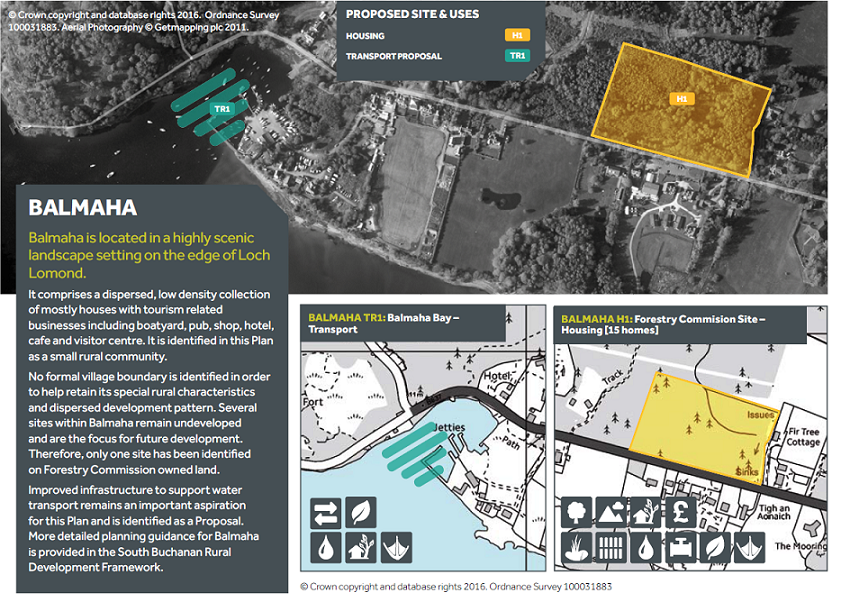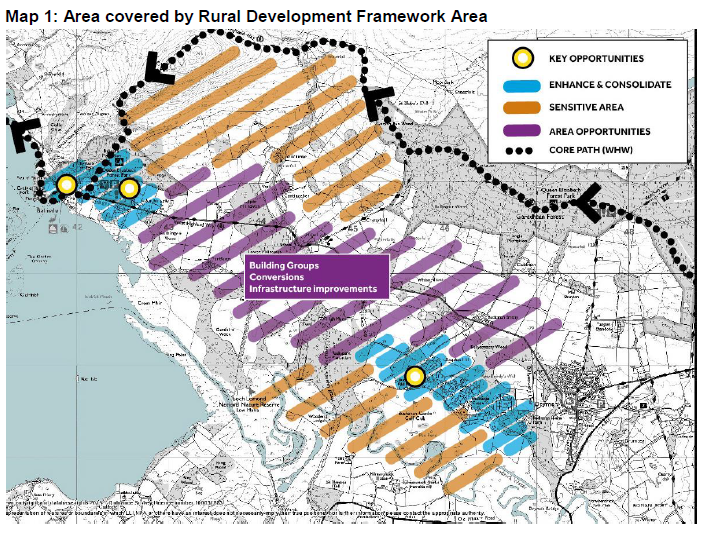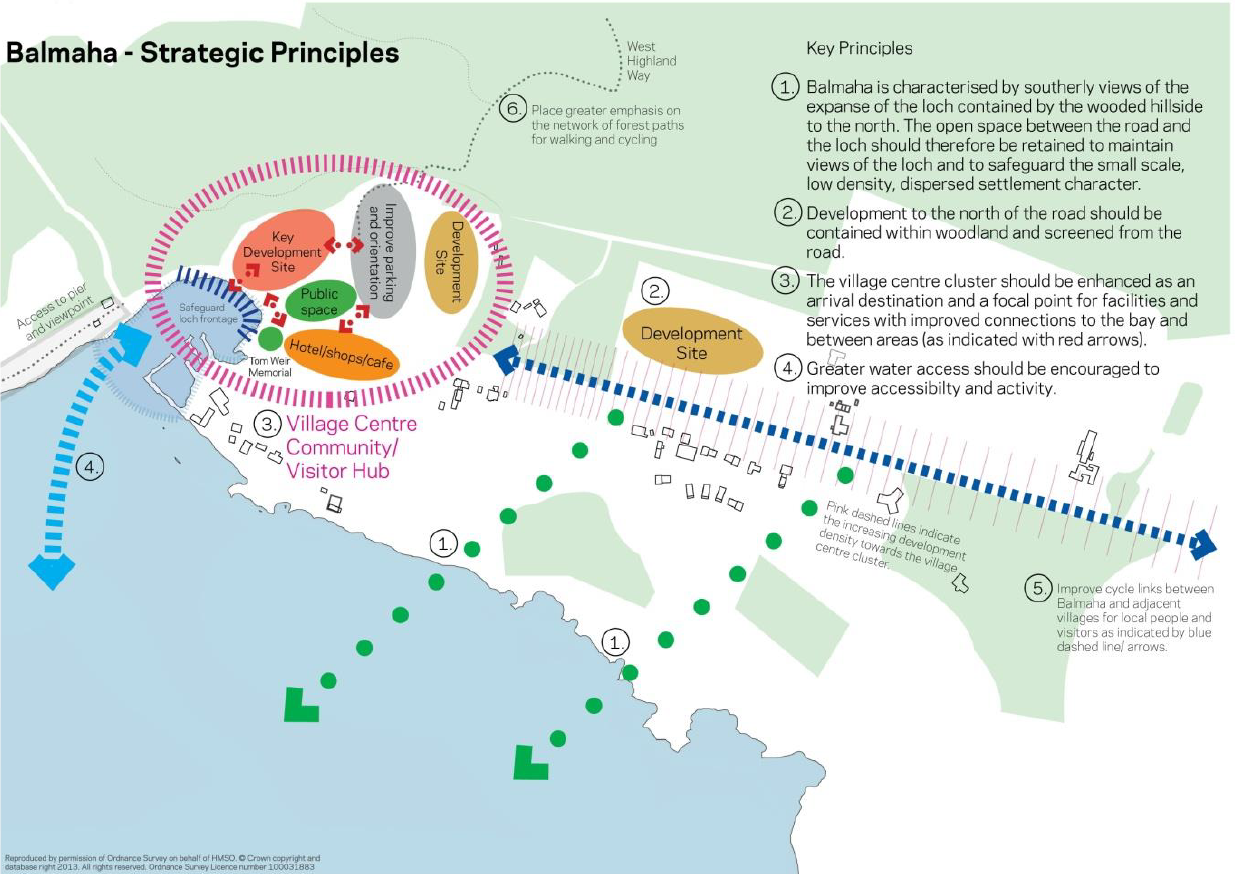
The chaos at Luss (see here) on the first weekend in May, was experienced at several other visitor hotspots in the Loch Lomond and Trossachs National Park, but most notably and predictably at Balmaha. The LLTNPA has an opportunity to reflect on what happened when its Planning Committee considers draft Supplementary Planning Guidance (SPG) for Buchanan South (see here) at its meeting today. The SPG is also very relevant to the controversial proposed housing development in the Balmaha Plantation (see here). This post considers whether the new SPG will help address the issues at Balmaha in a way fitting for a National Park.
There are strict rules on what can be included in Supplementary Planning Guidance, which can only expand on, not change Development Plans.

What the LLTNPA Development Plan, approved by the Scottish Government earlier this year, proposed for Balmaha (see above) was however extremely vague. It allowed considerable scope therefore for the Supplementary Planning Guidance to draw on the Park’s policies, and explain how these would be applied to the area.

In the event the SPG only covers three of the policies set out in the Development Plan, Housing, Economic Development and Visitor Experience. The reason for this is not explained but the SPG does not cover over policy areas which are very relevant to Balmaha such as Transport and Natural Environment, the village being bordered by the Loch Lomond National Nature Reserve and the Highland Boundary fault.
Visitors and visitor management at Balmaha
While Balmaha is not readily accessible, it is the easiest place to get to on the east shores of Loch Lomond and, with Conic Hill providing one of the best viewpoints in Scotland for a hill of its size and with the West Highland Way providing a walk along the loch shore, its not surprising the village is a popular tourist destination. With a poor bus service most people arrive by car. With just a hundred odd places in the carpark, and the road north of the village designated a clearway, its hardly surprising that cars overwhelm the village on sunny weekends and bank holidays.

The Park has recognised this in its new draft National Park Partnership Plan (above), which rightly states the “the road network can become very busy at peak times” but then in usual fashion partly blames this on visitors “problems can be exacerbated by illegal and irresponsible parking of vehicles”. Actually, this “problem” is what the LLTNPA was set up to address and its challenge I would suggest (its not easy) is the provision of infrastructure to support visitors, including alternative means of transport to get to popular places like Balmaha.
The Supplementary Planning Guidance, disappointingly, says almost nothing about this.

There is a reference to improving water transport (light blue arrow) and the Sustrans cycle path (dark blue arrow) but nothing on how the issue of too many cars for too few car parking places with no alternatives will be addressed. For once I agree with Gordon Watson, the LLTNPA Chief Executive, who stated to the Stirling Observer that “additional overflow” car parking places are required. Such provision used to be available. A farmer opened up a field to provide for parking but was given no support to manage this – people set up tents to stay the weekend – so stopped doing so. This is the obvious solution, one that is used successfully in England’s National Parks, and one that should be revived, but there is no mention of this in the SPG. I suspect this is because it would require resources from the LLTNPA (such as its Rangers helping to manage traffic rather than spending time chasing away innocent campers).
The lack of join up with the East Loch Lomond Visitor Management Plan 2014-19 – which the SPG interestingly refers to as “draft” even though it is published – is glaring. That plan recognised the pattern of visitor pressure and committed to:
The SPG contains no hint of this vision, or of the aspiration of past plans, yet alone how land might be used to achieve this. Another opportunity to make things happen, make things better, lost. It should not be difficult. On the continent many places, not just National Parks, use school transport at weekends and holidays to provide public transport to rural areas for visitors. Balmaha and east Loch Lomond is an obvious place to start given the road is not a through route.
The SPG contains almost nothing outdoor recreation in its broadest sense, the reason most people visit Balmaha in the first place – what the Park calls “Visitor Experience”. This is illustrated by the Balmaha strategic principles diagram (above) which includes nothing about how, once people have parked their cars in the car park, they leave the village. The green lines on the diagram indicate views to the Loch should be maintained but nothing about how people might access the loch shore and the National Nature Reserve, which is supposed to be a place people can enjoy nature. There is no obvious way to access this at present. The thinking of the LLTNPA appears to have gone backwards since the proposal, several years ago, to create a path along the loch shore south of the village (abandoned I understand because the ground is very boggy). To the north, the West Highland Way to Rowardennan offers brilliant walking but with no way to get back unless you are prepared to retrace your steps or go the full way and try your luck with a waterbus. A hop on hop off shuttle bus would open up the West Highland Way for far more people to enjoy.
There is also nothing about the lack of camping provision, the major issue being backpackers along the West Highland Way have nowhere to stop off at the natural stopping off point of Balmaha because of the camping management zone. This is the National Park’s welcome to walkers who come from all over the world. The LLTNPA in response to comments on the draft Development Plan saying a campsite was needed at Balmaha, indicated that there was nothing in the Plan to prevent this: the failure of the LLTNPA even to mention the need for a campsite in the SPG tells you I think that the LLTNPA has no intention ever of trying to make this happen. There is an obvious place for this: the former playing field, marked development site, within the pink circle in the diagram above and adjacent to where the West Highland Way enters the car park.
Developments in Balmaha
The focus of the Supplementary Guidance is on the LLTNPA’s Housing and Economic Development Policies which I believe confuses rather than clarifies matters:
New development within Balmaha should reinforce its existing development pattern and be of appropriate (generally small) scale.
What the LLTNPA means by “small-scale” however is not the same as what most people would understand by the term:
All new development should be of appropriate scale. It will be site dependant but generaIly groupings of 3-8 dwellings should be the most easy to set comfortably in more open landscape. Small groupings should be based on existing development patterns where one (generally larger) property faces onto the road, with other smaller properties behind. If there is a need for larger development (i.e. more than 5 houses) it should be divided by robust landscaping and areas of open land to reduce the impact of development
The Strategic Principles diagram above includes some grey lines on either side of the road (the dark blue line with arrows), increasing in density as they approach the centre of the village. This looks like the LLTNPA is proposing to allow ribbon development either side of the road even though this was not part of the Development Plan. This would explain why, unlike other settlements, the LLTNPA has not demarcated the village boundary. It also could explain why the people who I understand are the two main landowners, the Duke of Montrose and Sandy Fraser of the Oak Tree Inn, responded so positively to the draft Supplementary Guidance (see here) about opportunities for development.
The clarifications in the Supplementary Planning Guidance that the LLTNPA will allow more new build at Balmaha raises questions about why the Balmaha Plantation site (which is still waiting to go to Committee) ever needed to be earmarked for affordable housing. LLTNPA’s recently approved policy on Housing in small rural developments is that “Development on these sites should provide for 100% affordable housing”, so by allowing more housing at Balmaha, the need for affordable homes could be met without destroying what appears to be an area of ancient woodland. Except that, in Balmaha the SPG now qualifies that Park Policy: “Some open market housing will be supported where this is demonstrated as necessary to help fund the provision of affordable housing on site.” I expect the landowners will claim they can afford to construct very little affordable housing and that therefore the Balmaha Plantation site is still needed while very little affordable housing will be provided along the ribbon development. The effect of the SPG therefore will be to reinforce the current trends towards social segregation of people and housing in Balmaha.
Setting aside the question of how else to provide affordable housing, the Balmaha plantation proposal still appears to be a glaring anomaly within the context of the Development Plan and SPG. The SPG fails to refer to the LLTNPA’s Natural Environment policies – a chance to explain the claim, made by some, that the plantation is not really an Ancient Woodland site. It also fails to explain how the size and density of the Balmaha Plantation proposal fits with the definition of the type of small scale development the SPG wishes to see in the area, 16 rather than 3-8 units, with density decreasing as you move away from the village centre.
What needs to happen
The LLTNPA needs to start joining up its various plans and to start implementing actions it proposed to do in the past but has since, without explanation, abandoned.
The LLTNPA needs to revive the east Loch Lomond Visitor Management Group (which did not meet last year) but make this both representative (recreational organisations were not included) and accountable (it is not clear who signed off or agreed the last plan and the LLTNPA failed to provide any resources to make it happen).
The LLTNPA needs to start implementing its development plan policies on a consistent basis, rather than changing them so soon after they were adopted. If the LLTNPA won’t abide by its own planning policies, there is no reason why anyone else should.